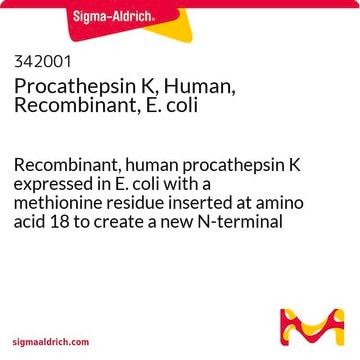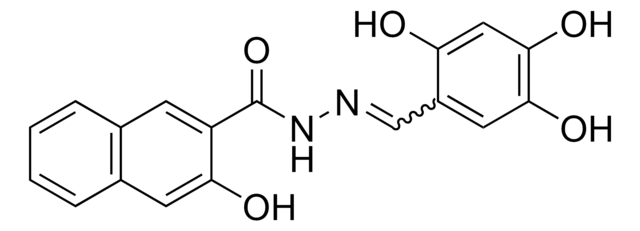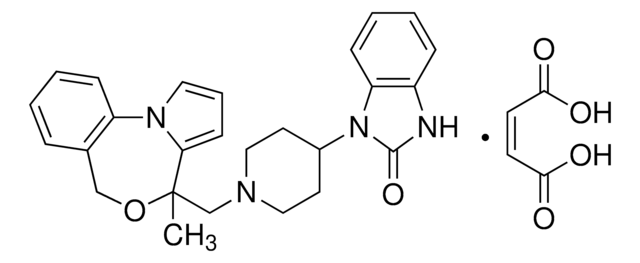SRP6001
Procathepsin K human
recombinant, expressed in E. coli, ≥95% (SDS-PAGE)
Sinónimos:
CTSK, CTSO, CTSO2
Iniciar sesiónpara Ver la Fijación de precios por contrato y de la organización
About This Item
Productos recomendados
biological source
human
recombinant
expressed in E. coli
assay
≥95% (SDS-PAGE)
form
liquid
packaging
pkg of 10 μg
concentration
~200 μg/mL
impurities
Endotoxin, tested
NCBI accession no.
shipped in
dry ice
storage temp.
−70°C
Gene Information
human ... CATK(1513)
General description
Procathepsin K is the inactive proenzyme of cathepsin K. Cathepsin K is a lysosomal cysteine protease and part of the papain cysteine protease family. It is expressed in osteoclasts. The gene encoding this protein is localized on human chromosome 1q21.
Biochem/physiol Actions
Cathepsin K has a role in bone resorption and remodeling. It has a triple helical collagen hydrolase activity. Mutations in the gene encoding this protein have been linked to pycnodysostosis.
Physical form
Liquid (25 mM Tris pH 8.0, 500 mM NaCl)
Other Notes
Procathepsin K can be activated by adjusting the pH 4.0 by adding an equal volume of 100 mM NaAc pH 3.9, 10 mM DTT, 5 mM EDTA followed by incubation for 40 min at RT. Activated mature Cathepsin is highly auto-proteolytic at pH 4.0, and care must be taken to avoid self-proteolysis. If the activated enzyme is not used immediately, we recommend to add methyl methanthiosulfonate (1 mM final concentration; MeS-SO2Me; MMTS) and to freeze the sample in liquid nitrogen or on dry ice. The hydrophobic thiol-reactive compound MMTS modifies cysteine′s by attaching its relatively small, uncharged thiomethyl-blocking group to reactive sulfhydryl groups (Nishimura et al., 1975). This reversible reaction arrests the auto-proteolytic process. The activity of the enzyme can be restored to nearly unmodified levels by adding L-cysteine (3M excess over MMTS) to the enzyme solution.
Storage Class
12 - Non Combustible Liquids
wgk_germany
WGK 3
flash_point_f
Not applicable
flash_point_c
Not applicable
Certificados de análisis (COA)
Busque Certificados de análisis (COA) introduciendo el número de lote del producto. Los números de lote se encuentran en la etiqueta del producto después de las palabras «Lot» o «Batch»
¿Ya tiene este producto?
Encuentre la documentación para los productos que ha comprado recientemente en la Biblioteca de documentos.
Joaquín Bobillo Lobato et al.
Medicina clinica, 145(7), 281-287 (2015-02-11)
Gaucher disease is an inherited disorder caused by deficit of acid β-glucocerebrosidase, responsible for the degradation of glucosylceramide to ceramide and glucose. Although the disorder is primarily hematologic, bone is the second most commonly affected structure. Cathepsin K (CATK) is
Xianglan Huang et al.
Calcified tissue international, 96(5), 373-378 (2015-03-03)
Pycnodysostosis is a rare autosomal recessive skeletal dysplasia characterized by short stature, osteosclerosis, acro-osteolysis, frequent fractures, and skull deformities. Mutation in the gene encoding cathepsin K (CTSK), which is a lysosomal cysteine protease, has been found to be responsible for
Vito Turk et al.
Biochimica et biophysica acta, 1824(1), 68-88 (2011-10-26)
It is more than 50 years since the lysosome was discovered. Since then its hydrolytic machinery, including proteases and other hydrolases, has been fairly well identified and characterized. Among these are the cysteine cathepsins, members of the family of papain-like
Guangxian Zhao et al.
PloS one, 10(8), e0136093-e0136093 (2015-08-25)
Cysteinyl cathepsin K (CatK) is one of the most potent mammalian collagenases involved in cardiovascular disease. Here, we investigated the clinical predictive value of serum CatK levels in patients with chronic heart failure (CHF). We examined 134 patients with CHF
Adeleke H Aguda et al.
Proceedings of the National Academy of Sciences of the United States of America, 111(49), 17474-17479 (2014-11-26)
Cathepsin K is the major collagenolytic protease in bone that facilitates physiological as well as pathological bone degradation. Despite its key role in bone remodeling and for being a highly sought-after drug target for the treatment of osteoporosis, the mechanism
Nuestro equipo de científicos tiene experiencia en todas las áreas de investigación: Ciencias de la vida, Ciencia de los materiales, Síntesis química, Cromatografía, Analítica y muchas otras.
Póngase en contacto con el Servicio técnico








